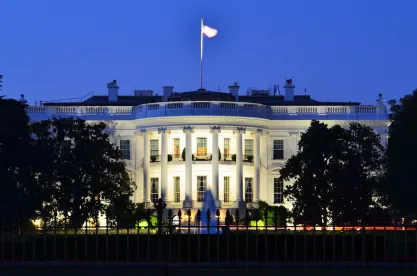On October 7, 2021, the White House Council on Environmental Quality (“CEQ”) released its notice of proposed rulemaking for revising its implementing regulations under the National Environmental Policy Act (“NEPA”). Long expected, the proposal is the first installment on a promise of broader changes to come—perhaps reflecting the difficulty of getting a full package of revisions through the inter-agency review process. The proposed rulemaking is the first phase of a two-phase process to address the NEPA revisions undertaken by CEQ during the Trump Administration and finalized in 2020. CEQ is now proposing to reintroduce previously eliminated provisions related to “purpose and need” and to recodify definitions for direct, indirect, and cumulative effects. In doing so, the CEQ will reinstate key terms and provisions from the 1978 NEPA regulations. The Phase One rulemaking also clarifies that the CEQ regulations are a floor, and not a ceiling, and that agencies have the latitude to develop their own approaches to environmental review. The current administration intends to develop a Phase Two rulemaking to tackle the 2020 NEPA revisions more broadly, with particular focus on integrating the Biden administration’s policies on climate and environmental justice. The comment period for the Phase I proposed rule begins on October 7, 2021 and will end in 45 days, on November 21, 2021.
The Phase I rule restores the traditional definition of purpose and need at 40 C.F.R. § 1502.13. The “purpose and need” is the reason for and goal of the federal action under consideration. The statement of purpose and need in an environmental impact analysis is an important element of NEPA practice as it shapes the range of alternatives to be considered by an agency (and thereby limits or expands the scope of the federal environmental review). The Trump administration expressly qualified an agency’s consideration of the purpose and need for an action by providing that “[w]hen an agency’s statutory duty is to review an application for authorization [e.g., a permit], the agency shall base the purpose and need on the goals of the applicant and the agency’s authority.” Supporters argued that this addition only codified common sense and case law saying that an applicant’s purpose in seeking federal action should inform the purpose and need of the proposed federal action. However, CEQ proposes to eliminate this phrase after concluding that “[a]gencies should have discretion to base the purpose and need for their actions on a variety of factors, which include the goals of the applicant, but not to the exclusion of other factors.”
In other words, agencies under the new regulation will be more free to modify the purpose and need of their action without being unduly constrained by an applicant’s goals. Indeed, the proposed rule’s preamble states that “an applicant’s goals themselves could be potentially confusing or unduly narrow or restrictive.” (emphasis added). An expanded purpose and need may lead to an increased number of alternatives (some of which may be unpalatable to an applicant or beyond the authority of the agency to require).
CEQ is also reintroducing the classic 1978 definition of effects. The Trump-era NEPA regulations had consolidated direct, indirect, and cumulative effects (or impacts) under the simple term “effects.” The Trump-era definition of effects also stated that a “‘but for’ causal relationship is insufficient to make an agency responsible for a particular effect under NEPA.’” In reinstating the classic 1978 definitions of “direct effects,” “indirect effects,” and “cumulative effects,” CEQ is removing the Trump-era provision that “but for” causal relationships are not sufficient to attribute an impact to agency action. CEQ explains that the “but for” proviso is confusing and might limit agencies in consider the full reach of “reasonably foreseeable” impacts.
With respect to reasonable foreseeability, CEQ proposes to eliminate Trump-era language that directed agencies not to consider effects as significant when the effects are “remote in time, geographically remote, or the product of a lengthy causal chain.” By removing this language, the CEQ will allow agencies not merely to consider but to treat as significant various climate change and environmental justice impacts, even when those impacts are temporally or geographically distant. All that matters is that such effects are “reasonably foreseeable”—not that they have a close causal relation to the proposed federal action. CEQ offered an example, observing that “when considering a potential Federal action that would permit fossil fuel extraction, it is reasonably foreseeable that the fossil fuel will be extracted, transported, and ultimately combusted to create energy, all of which cause air pollution that can have adverse public health and environmental effects.” This example may inspire heated comments and policy discussion, since it departs markedly from leading precedent in certain circumstances. In a significant footnote, CEQ states that federal agencies “may consider all available tools and resources in assessing [greenhouse gas] emissions,” including CEQ’s 2016 guidance document on evaluating greenhouse gases and climate change during NEPA review. CEQ also notes that the Interagency Working Group’s interim estimates on the Social Cost of Greenhouse Gases may be useful for federal agencies evaluating effects under NEPA.
Although the Phase I rulemaking may be best understood as reintroducing certain rules that most agencies and businesses seeking federal approvals are familiar with, CEQ will also reintroduce some of the uncertainty faced by project proponents when permitting or defending a project. By excluding certain alternatives or effects from agency consideration, the Trump-era NEPA revisions sought to better standardize agency NEPA review processes throughout the Executive Branch and to cabin the outer edges of what had to be considered by agencies. The proposed rulemaking would allow agencies to pursue their own approaches to NEPA compliance by examining an expanded purpose and need, considering longer-term effects of an action, and even developing agency-specific implementing regulations that are more complex or stringent than CEQ’s NEPA regulations. The return to pre-Trump terms, especially under the more expansive interpretation offered in the new proposal, would remove some of the defenses that would otherwise be available to agencies facing lawsuits alleging failures in considering alternatives and analyzing impacts.
As we noted, this is Phase I of a two-phase rulemaking. Although we do not know now what CEQ may propose in its more extensive revision of NEPA’s implementing regulations, CEQ has explicitly foreshadowed a prominent role for climate change and environmental justice in the NEPA of the future.






 />i
/>i
